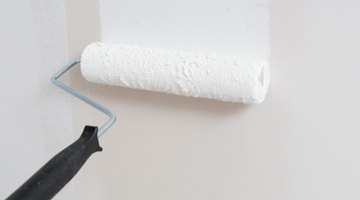The Best Primers to Cover a Joint Compound
Before applying a finish paint coat to new or repaired drywall, apply primer to ensure that the paint adheres evenly to the drywall surface and the joint compound used to cover the seams between drywall boards.

The condition of the drywall, the quality of the taping job and the type of top coat used are all things to factor in when selecting a primer.
Latex or Water-based Primer
The primers most commonly used on drywall and joint compound are latex or water-based. They ensure uniformity and proper appearance of the top coat, whether it is gloss or matte, and effectively hide any previous color on the wall. Within this category, high-build drywall primers are specially formulated to minimize the appearance of minor defects created when applying and sanding joint compound, such as sanding grooves, pinholes and paper fuzz. Latex primers clean up with soap and water.
Alkyd Primer or Oil-based Primer
Specifically designed for problem areas, stain-killing primers seal in water and other stains on drywall so they do not seep through the top coat. Stain killing primers are oil- water- shellac- or alcohol-based.
Stain Killing
Specifically designed for problem areas, stain-killing primers seal in water and other stains on drywall so they do not seep through the top coat. Stain-killing primers are oil- water- shellac- or alcohol-based.
Tinted Primer
Tinting primer so it is closer in color to your top coat helps achieve a uniform finish with fewer coats. Do-it-yourselfers can either add small amounts of the top coat to the primer, or specialized pigments can be added where the primer is purchased, which is particularly effective when using medium-to-dark shades. When painting with deep tones, as opposed to whites or pastels, tint towards gray rather than the actual finish color.
References
Writer Bio
Matt Brown has been writing professionally for more than 15 years. He shares his experience in home remodeling and do-it-yourself projects with his readers. Brown earned his bachelor of arts in communications from Marist College in Poughkeepsie, N.Y.
Photo Credits
- Jupiterimages/Photos.com/Getty Images
- Jupiterimages/Photos.com/Getty Images
More Articles



